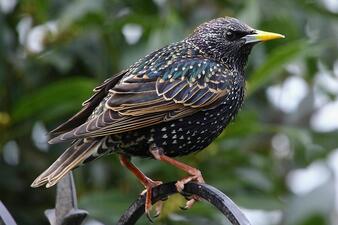
Starling, starling, nobody’s darling
Getting into everything, but I adore the hymns you sing
And I love the coat you wear, murmuring upon the air
I wrote this poem this morning which, of course, is America-centric. Poetry, like music, is experiential. You cannot have phenomenological or narrative writing by a Pennsylvanian without it appearing America-centric. It’s unavoidable. The only other option is to write in bland generalizables, rather than from actual lived experience. However, I’ve always felt more Appalachian than American, though I doubt that helps many who think scholarship is already too overly focused on the U.S. Appalachia is a place. The U.S. is a nation—a modern fiction with a military, education and prison systems, and a history of colonization, oppression, and exploitation. Appalachia is, in contrast, one of the oldest mountain ranges in the world that manages to cultivate some of the most amazing musical traditions in spite of its ongoing exploitation by nations, such as the U.S. For instance, Appalachia is the focal point of both mountaintop coal removal and natural gas pipeline construction, making the coasts wealthy, but despite being the source of this wealth, Appalachia is home of persistent poverty.
Anyway, back to my reflection on starlings—little stars of my local park’s sky. In many parts of Europe the starling is a beloved wild animal who is struggling to survive the 21st Century’s ecological challenges. Here in Appalachia though, most people have long learned to loathe the starling, and to see this non-native migrant as ecologically destructive.
In 1939, a mere half-century after starlings’ introduction, the founding mother of the global environmental movement, Rachel Carson penned an article for Nature magazine, How About Citizenship Papers for the Starling? Unlike the more recent and well-known non-native to Florida, the Burmese Python, brought over as exotic pets, the starling was brought over in a determined act by a specific person, Eugene Schieffelin, and at a specific time, in 1890-1. He had, in previous years, attempted to introduce starlings with only a few breeding pairs, which had not survived in New York’s unfamiliar ecosystem. But by 1890, Schieffelin introduced 80 and 40 birds respectively. This introduction was part of an attempt to acclimatize non-native species to America, all of the species Shakespeare wrote of, to make European-born Americans feel more comfortable. Starlings are and were beloved wild animals in Europe. These societies were successful in introducing many species we take for granted here in Appalachia today, including our dominant grasses, dandelions, and house sparrows.
Returning to Carson’s article, starlings are here to stay. Starlings hunt Japanese beetles, weevils, plant-eating scarabaeoids, cutworms, grasshoppers, millipedes, and ground beetles. For farmers, starlings are “economically the superior of the robin, the catbird, the red-winged blackbird, the grackle, the cowbird, or the English sparrow” (p. 317). Nonetheless, many ecologists are starling-averse because starlings despoil the nests of other bird species. However, starlings strive in cities, and their nest despoiling habits are similar to that of other species, and hasn’t been linked to recent species collapse. Rather, our human expanding suburbs, internet server farms, and other "development" projects are stealing species’ habitats, and, unlike many species of concern, starlings thrive where humans live.
In 2015, the U.S. government killed more than a million starlings, though these efforts haven’t changed the starling population, which has been stable for decades. Our government’s impotent efforts to remove starling populations means chemical warfare. For instance, the USDA uses DRC-1339 to kill starlings because it is not “anticipated” to kill or harm species other than blackbirds, grackles, cowbirds, starlings, pigeons, collared-doves, crows, ravens, magpies, and gulls. I don't see the risks as worth the perceived benefit.
Starlings in the U.S. thrive in cities, suburbs and towns. They don’t thrive in wilderness—not in forests or deserts or plains. Rachel Carson recommended we end our war on starlings, and accept them as part of the ecosystem, which they’ve now been a part of for 130 years. It is a very Western mode of thinking to label starlings as good (in 1890) and needed, or to label them bad (today) and move heaven and earth to eradicate them. Neither of these rationalities or actions are better than the other. Both are colonial thinking. Both create ecological destruction. But a humility that is too often absent in Western thought is appropriate when it comes to starlings and other migrant species. I fail to hear Native American groups asking the U.S. government to cover the soil with pesticide in an inept attempt to kill all of the starlings descended from Schieffelin’s sin. (I use the word "sin" here purposefully, because our actions on the starling are the same as how we in the West conceive of sin requiring penance).
How does this relate to music education? Since I’m hired by Penn State Altoona to teach classical music, it is of note that Wolfgang Amadeus Mozart, who kept birds as pets throughout his life, kept a starling during three of his most productive years. As pets, starlings are perhaps more musical than canaries, being one of the best sound imitators in the aves class. They have mischievous personalities, and Star, Mozart’s starling, influenced his compositions, “serving as his companion, distraction, consolation, and muse.” We can take our students outside, even if we don’t choose to keep a musical class pet to model Mozart. Outside we can help students identify all of the musicians in their soundscape. This, I believe, is the start of a music education that humbly respects clean land and water, and ecosystems that support diverse bird species and life on Mother Earth.
DS
Link to Starling image: https://upload.wikimedia.org/wikipedia/commons/6/61/Starling_%285503763150%29.jpg
 RSS Feed
RSS Feed
